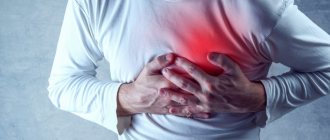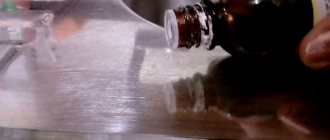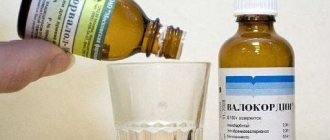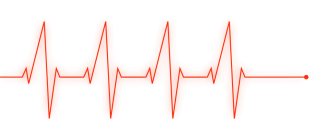Medicines > Corvalol (drops)
This information cannot be used for self-medication!
Consultation with a specialist is required!
Corvalol drops belong to a group of drugs that have antispasmodic and sedative effects, and also make it easier to fall asleep. This is a combination drug, its overall effect is due to the combination of substances included in the drug. The drug is sold without a prescription, available in the form of drops for internal use, available in glass bottles of 25 or 15 ml.
The composition of the drops per 1 ml includes 20 mg of ethyl ether, 1.42 mg of peppermint oil, 3.15 mg of sodium hydroxide, 18.26 mg of phenobarbital, 0.58 ml of the highest purity rectified alcohol and 0.42 ml of purified water . Peppermint relieves spasms, dilates blood vessels, phenobarbital can gently soothe, it is also a sleeping pill. The components help reduce the resulting excitement of the nervous system and help you fall asleep.
Corvalol drops are prescribed to obtain a sedative and vasodilating effect in cases of cardiovascular system disorders, sleep disturbances, neuroses with increased irritability, tachycardia, and agitation accompanied by vegetative manifestations. Drops are also effective for intestinal spasms.
Take the drug in the following dosage: 15–30 drops before meals three times a day. If an attack of tachycardia occurs, the dose is increased to 40–50 drops. As for children, they are given 3–15 drops, based on the age of the child, dividing them into two or three times. The optimal course of treatment will last as many weeks as the doctor says - treatment is individual.
Usually Corvalol is well tolerated by patients, only occasionally daytime drowsiness and mild attacks of dizziness occur. If the drug is taken for a long time, depression, rhinitis, apathy, hemorrhagic diathesis, conjunctivitis, or even impaired coordination of movements in the patient may develop.
Contraindications: renal, liver failure, hypersensitivity to the components of the drug, lactation period. Take with caution throughout pregnancy, the decision is made by the attending physician.
Store the medicine for up to 1.5 years in a dark place, away from children. The air temperature should not exceed 15 degrees.
Reviews about “Corvalol (drops)” from doctors and patients:
Cheap.
Previously, there was opium for the people, now it is Corvalol. Let me explain with an analogy. Truly massive and extremely popular Corvalol was invented in Germany (more precisely, its almost complete analogue is Valocordin). They filmed the post-war depression in the 50s. last century.
Why do I care? Yes, because my elderly relatives drink Corvalol and everyone considers it harmless drops. Well, who doesn’t know Corvalol, its smell, taste? Meanwhile, not a single normal study has been conducted in our country on the effect of this drug on the health of older people. It is known that rats treated with phenobarbital throughout their lives died from cancer. Symptoms of chronic intoxication are also known: drowsiness, irritability, weakness, confusion, hallucinations, convulsions, imbalance, as well as changes in the functioning of the cardiovascular, digestive and urinary systems.
Now think about why your grandmother developed dementia (senile dementia) so early, and why your grandfather died of cancer.
Corvalol: instructions for use
Popular articles
Application of Corvalol
Corvalol is a combination drug that contains phenobarbital, peppermint oil, water, ethyl alcohol and ethyl ether. Thanks to phenobarbital, which has a vasodilating effect, peppermint oil acts more effectively, reducing spasm and dilating blood vessels. When the dose is increased, Corvalol acts as a hypnotic. The drug is used for neuroses of various origins with heart pain and increased irritability, angina pectoris, intestinal spasms, rapid heartbeat, hypertension. Corvalol is well tolerated and may only occasionally cause mild dizziness and drowsiness.
Corvalol drops: dosage
As such, there is no dosage of Corvalol. In the form of drops, the drug is available in 25 ml bottles. They should be taken before meals three times a day, 15-20 drops dissolved in a small amount of water. If necessary, the dose can be increased to 30. In case of an acute attack of tachycardia and severe pain in the chest area, you can drink 40-50 drops. Children can be given from 3 to 15 drops per day. You should not increase the dose on your own or experiment with this drug, as it can cause an overdose. Symptoms of overdose are memory impairment, impaired motor coordination, and the development of a depressed state. In this case, it is necessary to reduce the dose or stop taking the medicine altogether.
Is Corvalol prohibited? Can I take it?
For most people, Corvalol is considered a cure-all, but in fact it cannot be considered useful in the treatment of cardiovascular diseases. Its only effect is to dilate blood vessels and have a calming effect. Corvalol relieves certain symptoms that are caused by stress, not disease. The components of the drug (ethyl bromizovalerate, ethyl alcohol, phenobarbital) accumulate in the body and cause poisoning of internal organs. With long-term use, psychological and physiological dependence is formed (due to phenobarbital, a psychotropic substance that causes depression of the central nervous system and is a hard drug), which leads to poor sleep, anxiety, depression, and memory impairment. In many countries, Corvalol is prohibited, but in Russia it is only available by prescription. So before you take this drug, think about whether you want to die from it?
Drugs to lower heart rate
Drugs to lower heart rate
Heart rate (HR), or pulse, is one of the most sensitive indicators of our condition. It is influenced by both strong emotions and physical activity, external factors, including weather conditions. Since the mentioned factors lead to increased oxygen consumption, the pulse quickens to adapt to the tone of the body. After all, to cope with physical and emotional stress, more oxygen and nutrients are required. The “afterburner” mode of the heart is turned on, which manifests itself in the form of a rapid pulse.
What pulse is considered rapid?
In a healthy adult, the normal heart rate usually varies in the range of 60–90 beats per minute. A pulse less than 60 is considered low (bradycardia), more than 90 is considered high (tachycardia). In a normal state, a person does not pay attention to the work of the heart and takes the condition for granted. With tachycardia, you can literally hear it beating, feel tightness in the chest and difficulty breathing. If after a short rest the heart rate decreases to normal levels, then this process is considered physiological (natural).
To correctly assess a person’s condition and select the optimal treatment method if a pathology is detected, specialists pay attention to a number of additional points:
- blood pressure (high or low);
- presence of chronic diseases;
- lifestyle (active or sedentary);
- taking tonics and medications;
- other factors that can affect heart rate.
Causes of rapid heart rate
Tachycardia can develop due to various reasons. Among them, three broad categories can be distinguished.
Organic. These causes are associated with diseases of the cardiovascular system or other organs (both congenital and acquired). Pathological tachycardia is characterized by an increase in heart rate at rest, i.e. it is not caused by physical activity or emotional shock. At the same time, when the heart beats quickly, it does not have time to relax and fill. This reduces the release of blood, which leads to oxygen starvation of the heart muscle and the entire body. Pathological tachycardia is characteristic of cardiosclerosis, rheumatism, heart disease, myocardial infarction, circulatory failure and other diseases. Also, rapid heartbeat can accompany chronic anemia, thyrotoxicosis, acute pain attacks (for example, hepatic colic).
Psychogenic. Stress can be caused not only by a sad event, work pressure or family difficulties. Manifestations characteristic of stress (increased heart rate, excitement) can also be caused by the anticipation of a joyful event: meeting with friends, the birth of a child, transfer to a new position. Thus, an emotional outburst is often accompanied by tachycardia. If a person is healthy, this condition passes quickly.
Physiological. In this case, increased physical activity, changes in environmental conditions (for example, heat or cold), thirst, hunger, injury contribute to the emergence of a natural reaction of the cardiovascular system, which is expressed in a short-term increase in heart rate. Physiological tachycardia can manifest itself in an increase in heart rate to 90–180 beats per minute (but not higher). But, as a rule, after about 5 minutes, after eliminating the causes, the heart rate returns to normal. It is important to know that physiological tachycardia is not characterized by chest pain, dizziness, and visual disturbances (blurred vision and spots before the eyes). If these symptoms are present, most likely there is pathological tachycardia and you need to consult a specialist as soon as possible.
Diagnostics
If a person constantly has a high pulse (and especially if there are other alarming symptoms), it is necessary to contact a cardiologist and undergo a full diagnosis. To identify the cause of the increase in heart rate, you will have to do an extensive examination of not only the heart, but also other organs.
The minimum scope of diagnostics includes:
- electrocardiography,
- general blood analysis,
- blood test for thyroid hormones.
At the request of the doctor, additional studies are prescribed to confirm or clarify the diagnosis:
- Holter,
- Ultrasound of the thyroid gland,
- blood chemistry,
- Ultrasound of the heart with Dopplerography.
Drug Treatment Options
The choice of drugs to slow down the pulse and combat tachycardia always remains with the doctor. Self-medication can lead to dangerous health consequences. After the diagnosis has been established, the patient may be prescribed the following groups of drugs.
Beta blockers. They are often prescribed as heart rate-lowering pills. Such drugs block beta-adrenergic receptors, which not only helps to reduce heart rate, but also reduces the effects of stress on sensitive people. At the same time, blood pressure decreases, making these pills for lowering heart rate especially effective for high blood pressure. But beta blockers can only be used under the strict supervision of the attending physician, as they have an impressive list of side effects and contraindications.
Sedative medications. They are prescribed as drugs to reduce heart rate if the increase in the latter is associated with constant anxiety or emotional arousal. One of the medicines in this category is Corvalol PHYTO1. It is available in the form of drops and tablets. The main active ingredients of the drug to reduce heart rate are motherwort extract, peppermint leaf oil and ethyl bromizovalerianate. The latter reduces the excitation of the central nervous system and enhances the inhibition of subcortical structures. The mint oil contained in the preparation irritates the cold receptors of the oral cavity, due to which the blood vessels of the heart and brain dilate. Motherwort extract lowers blood pressure and reduces heart rate. The medicine does not contain phenobarbital.
Statins. The action of the drugs is aimed at lowering cholesterol levels. Statins can be used to treat and prevent atherosclerosis. They improve the condition of the walls of blood vessels and improve blood supply to the myocardium. The results of taking such drugs are usually visible after 1–2 months.
___________
1 Has contraindications. Before using the drug, consultation with a specialist is necessary.
Corvalol
Corvalol belongs to the group of sedatives. It contains phenobarbital, which is a psychotropic drug, isovaleric acid ester and peppermint leaf oil. Due to the last component, not only the specific smell of Corvalol is provided, but also a reflex antispasmodic and vasodilating effect. A derivative obtained from valerian roots has a calming effect on the nervous system, and in large doses causes drowsiness. Thus, the effect of Corvalol is due to its composition, which, in addition to the listed components, includes ethyl alcohol, sodium hydroxide and water.
Previously, there was only liquid Corvalol, drops of which had to be diluted with a certain volume of water. Currently, for the convenience of patients, Corvalol is produced in tablets for sublingual use.
Corvalol tablets are easy to use
It is interesting that this drug is distributed mainly in the Balkan Peninsula and in Russia. In other countries, they use a medicine that has a similar composition (valocordin). Phenobarbital, which is part of both drugs, is considered a drug in some countries (USA, Lithuania) and is prohibited for import.
Indications for use
The use of Corvalol is indicated for the following conditions:
- changes in the function of the cardiovascular system associated with impaired neurohumoral regulation;
- in complex therapy of neuroses, as well as with increased excitability and irritability;
- for taking the drug Corvalol, indications include difficulty falling asleep due to increased anxiety;
- tachycardia. associated with the influence of the sympathetic nervous system;
- early stages of hypertension and minor spasm of the coronary arteries;
- increased tone of the autonomic nervous system, accompanied by excitement;
- spasms and increased peristalsis of the gastrointestinal tract.
How many drops of Corvalol to take in a given case is determined by the doctor, but the average dosage is 20-40 drops three times a day.
Contraindications
Contraindications for taking Corvalol are individual allergic reactions and intolerance to the components of the drug, as well as severe somatic diseases accompanied by severe renal or liver failure.
The calming effect of Corvalol has a beneficial effect on the cardiovascular system
Overdose
If an acute overdose of Corvalol occurs, intestinal motility slows down, and this leads to constipation.
With long-term use of the drug, chronic bromine poisoning is possible, which is manifested by depression and apathy, as well as damage to the mucous membranes (rhinitis, conjunctivitis), blood vessels (hemorrhagic diathesis) and the central nervous system (impaired speech, memory, attention, unsteadiness of gait). Libido often decreases and impotence develops.
Side effects
Side effects usually do not occur with the correct dosage of the drug. However, dizziness and daytime drowsiness may sometimes occur. In some cases, drug dependence develops, and when it is discontinued, abstinence occurs.
Corvalol and alcohol
This drug is often used to eliminate symptoms that occur after drinking large amounts of alcohol (hangover). These include increased heart rate. increased blood pressure, increased excitability. Due to the fact that Corvalol and alcohol have a sedative effect, when used together, an overdose and various side effects may develop.
Corvalol during pregnancy
Corvalol can be used during pregnancy, as well as during breastfeeding, only under strict indications. That is, if the expected benefit exceeds the harm that is likely to be caused to the child. This is due to the fact that phenobarbital, which is part of this medicine, can negatively affect the condition and development of the baby’s central nervous system, and also lead to intrauterine hypoxia.
Corvalol for children
Corvalol can be prescribed to children in special situations, and the dose should be reduced depending on age (one drop per one year of life). Interestingly, some doctors prescribe its use almost from birth, while others do not recommend taking it before 12 years of age. Since there is no consensus on this matter, it is worth listening to the opinion of your doctor, since only he has sufficient information about the child.
Corvalol is an indispensable drug in some situations when it is necessary to eliminate the symptoms of severe shock or dysfunction of the nervous system. It is also suitable as a temporary measure for tachycardia and hypertension. However, with long-term use, Corvalol often causes addiction and the development of side effects. Therefore, you should not self-medicate, but rather seek help from a specialist.










